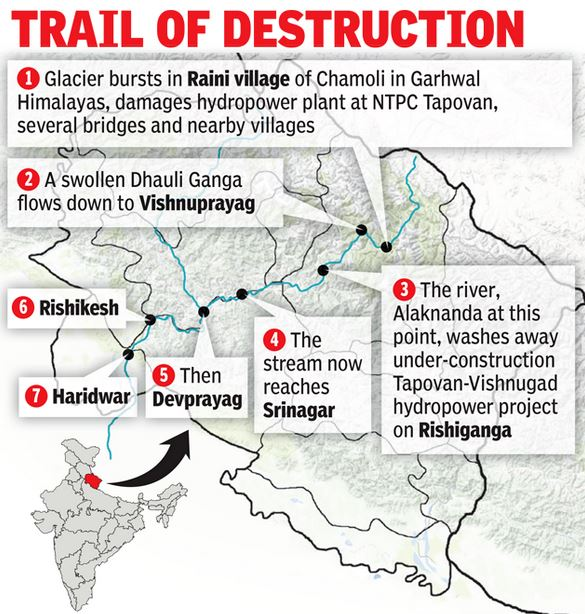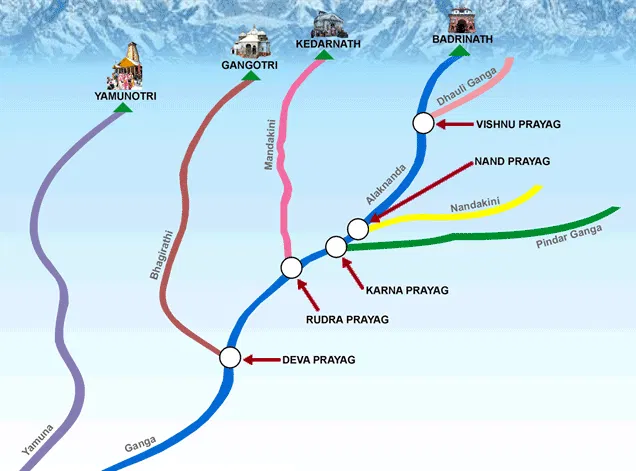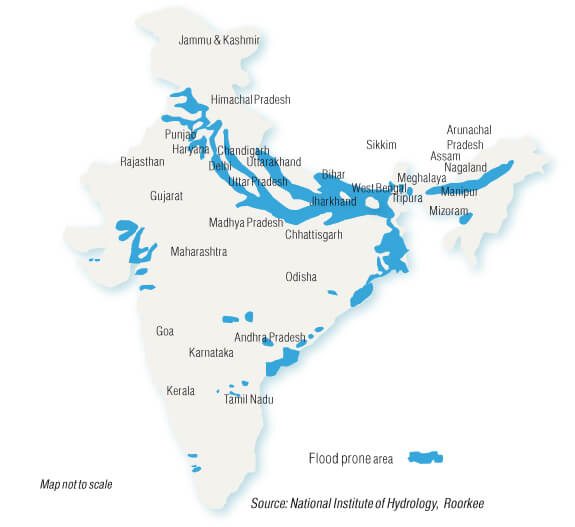Flash Flood
Why in News:
- The Geological Survey of India said that the flash flood in Chamoli district, Uttarakhand, was due to a large mass of snow, ice and rock avalanche along with a hanging mass of rock crashing into the Raunthi Garh valley floor.
What is a flash flood
- Flash floods are defined as floods that occur within six hours of heavy rainfall or another cause. However, flash floods can sometimes happen within minutes or just a few hours of a heavy rain.
- Flash floods are particularly dangerous because they combine a flood’s normal potential for damage with unpredictability and a rapid time frame. During a flash flood, normally dry creeks and river beds can fill with water and overflow before people have time to react.
How does it happen
- The intensity of the rainfall, the location and distribution of the rainfall, the land use and topography, vegetation types and growth/density, soil type, and soil water-content all determine just how quickly the Flash Flooding may occur, and influence where it may occur.
- It mostly happens due to extremely heavy rainfall from thunderstorms.
- Heavy rainfall isn’t the only potential cause of a flash flood. Melting snow and ice jams in mountain streams can send torrents of water unexpectedly into low-lying areas. Flash Floods can occur due to Dam or Levee Breaks, and/or Mudslides (Debris Flow).
Areas prone to flash floods
- Certain areas are prone to flash flooding because of a variety of conditions. For example, urban areas can be dangerous because the construction of buildings, highways, and large parking lots reduces the amount of soil available to absorb heavy rains.
- Areas near rivers and large streams are also prone to flash flooding, since heavy rains will naturally find their way to established waterways. Deep canyons and other areas near mountains and steep hills can be deadly when the surrounding topography produces rapid runoff that can flood normally dry areas in a matter of minutes.
Issues Associated with Flash Floods
- Forecasting of flash floods is tough
- Frequency of events have increased due to climate change
- Himalayas are a volatile mountain system
- Overlooking environmental norms may cause flash floods and this is primarily seen after dams are constructed without adequate risk analysis
How Chamoli disaster happened

- A contributory factor was unusually warm weather in the region.
- Observed change in the hydro-meteorological conditions (heavy snowfall followed by sudden warmer climate) possibly triggered this huge snow and rock avalanche/landslide causing sudden domino effect of flash flood in the downstream.
- Climate change that was triggering higher temperatures in the upper reaches of the Himalaya had a role and the constant freezing and thawing of ice made parts of rocks weak making them vulnerable to collapse.
- There was no evidence of a Glacial Lake Outburst Flood (GLOF) having caused the event
- Areas having risks posed by smaller mountain glaciers were also becoming important sites where such hazards formed.
- The steep higher order streams and the narrow river valleys in the high-altitude areas of Himalayas remain extremely hazard prone, which are not only vulnerable to GLOF (Glacial Lake Outburst Flood) /Landslide Lake Outburst Flood (LLOF) hazards but have also become locale for a major disaster caused due to the domino effect of large/mega landslide and avalanche
How the flood proceeded
- It occurred in river Rishi Ganga due to the falling of a portion of Nanda Devi glacier in the river which exponentially increased the volume of water.
- Rishiganga meets Dhauli Ganga near Raini. So Dhauli Ganga also got flooded.
Power Projects Affected:
- Rishi Ganga Power Project: privately owned 130MW project.
- Tapovan Vishnugad Hydropower Project on the Dhauliganga: It was a 520 MW run-of-river hydroelectric project being constructed on Dhauliganga River.
- Several other projects on the Alaknanda and Bhagirathi river basins in northwestern Uttarakhand have also been impacted by the flood.
Dhauliganga

- It originates from Vasudhara Tal, a glacial lake in Uttarakhand.
- Dhauliganga is one of the important tributaries of Alaknanda, the other being the Nandakini, Pindar, Mandakini and Bhagirathi.
- Dhauliganga is joined by the Rishiganga river at Raini.
- It merges with the Alaknanda at Vishnuprayag.
- From there the Alaknanda flows southwest through Chamoli, Maithana, Nandaprayag, Karnaprayag until it meets the Mandakini river, coming from the north at Rudraprayag.
- After subsuming Mandakini, the Alaknanda carries on past Srinagar, before joining the Ganga at Devprayag.
- Alaknanda merges with Ganga, first flowing south then west through important pilgrimage centres such as Rishikesh and finally descending into the Indo-Gangetic plains at Haridwar.
- The Ganges River originates in the Himalaya Mountains at Gomukh, the terminus of the Gongotri Glacier.
How to prevent flash floods
- Framework For Vulnerable Zones: framework for robust early warning systems, infrastructure development, construction, and excavation in vulnerable zones must be evolved.
- Reexamining HydroPower Option: IPCC report has assessed that the climate crisis has altered the frequency and magnitude of the natural hazards in high mountain regions of the world. Run of the River (ROR) projects can be an alternative
- NDMA Guidelines: construction of any habitation should be prohibited in the high hazard zone.
- Research on Glacial Lakes
Related Information
GLOF
- A glacial lake outburst flood (GLOF) is a release of meltwater from a moraine- or ice-dam glacial lake due to dam failure. GLOFs often result in catastrophic flooding downstream, with major geomorphic and socioeconomic impacts. Some of the largest floods in Earth’s history have been GLOFs
- Moraine-dammed lakes form during periods of glacier retreat from a moraine. As a glacier margin retreats, water collects in the topographic low between the ice-front and the abandoned frontal and/or lateral moraine. Most existing moraine-dammed lakes formed when mountain glaciers began to retreat from large moraine ridges constructed during the Little Ice Age.
- In contrast to moraine-dammed lakes, ice-dammed lakes form when drainage is blocked by a glacier that advances or becomes thicker. Consequently, ice-dammed lake growth is closely related to glacier mass balance and climate. Ice-dammed lakes form wherever a glacier blocks the drainage of meltwater.
GLOFs have three main features:
- They involve sudden (and sometimes cyclic) releases of water.
- They tend to be rapid events, lasting hours to days.
- They result in large downstream river discharges (which often increase by an order of magnitude).
LLOF
- Landslide Lake Outburst Floods (LLOFs) are common in the Himalayan river basins. These are caused by breaching of lakes created by landslides.
India’s fight against flash flood

- India is leading a delegation of countries, including Bhutan, Sri Lanka, Bangladesh, and Nepal, in the exchange of hydrological and meteorological data in order to prepare flash flood forecasts.
- The system was developed in collaboration with India’s National Disaster Management Authority (NDMA) and the Central Water Commission (CWC).
- The India Meteorological Department (IMD) has launched the South Asian Flash Flood Guidance System (FFGS), which is designed to assist disaster management teams and governments in developing timely evacuation plans ahead of a flooding event.
Geological Survey of India
- The Geological Survey of India (GSI) is a scientific agency of India. Founded in 1851, it functions under the Ministry of Mines..
- It is one of the oldest of such organisations in the world and the second oldest survey in India after Survey of India (founded in 1767), for conducting geological surveys and studies of India.
- It is also the prime provider of basic earth science information to government, industry and general public, as well as the official participant in steel, coal, metals, cement, power industries and international geoscientific forums.
Reference:
- https://www.thehindu.com/news/national/chamoli-disaster-due-to-avalanche-says-geological-survey-of-india/article35031786.ece

[…] Read about GLOF at https://officerspulse.com/flash-flood-2/ […]